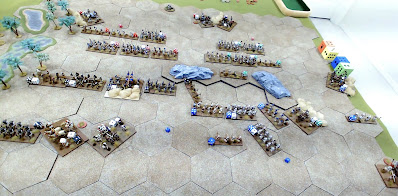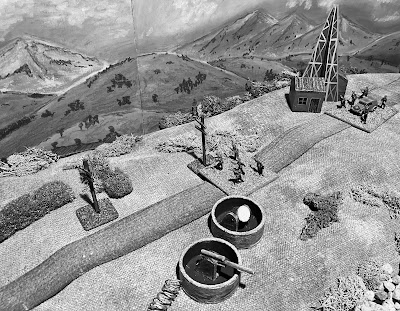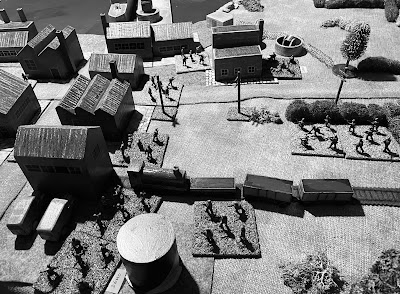This post describes the rules to be used for the commando raid game. The defender's reaction rules will be in my next post. The rules for this game are different from the original St. Nazaire game I played 3 years ago in two main ways. First, instead of tracking hits, units are now eliminated after failing a saving throw which means the shooting rules were reworked. Second, officer rules have been introduced, allowing units with officers to improve another unit's activation by foregoing their own activation.
 |
| Raiding commando units creating havoc. |
Turns
The game is played in turns with the commando player attempting to activate their commando units first. Followed by the German unit activations and reinforcements using the defined reaction rules (in the next post - part 3).
Unit Activation
Each unit in a player's force is activated once during the player's turn. Assuming a successful activation a unit can move, shoot, attempt a demolition of a target, or engage in hand to hand combat.
Note: German units don’t engage in hand to hand combat or demolition.
Activation Roll
For each activated unit roll a dice and adjust the score:
-1 for German forces to represent the confusion
+1 Officer direction (see Officer rule)
-2 if seen by searchlight (see Searchlight rule)
If the adjusted score is:
Less than 1 = no action allowed
1-2 = one action allowed
3-4 = two actions allowed
5+ = three actions allowed
Note: Pillboxes do not need to activate, they always have one shooting action until they are destroyed.
 |
| Units with officers and demolition units are labelled to avoid confusion. I use little tabs for marking books from the local stationary store. |
Movement
A move costs one action and units must move in a straight line for each action. If a unit is moving it must perform all its move actions together. A unit cannot split its move actions to move, shoot, and move again.
Commando units and German infantry units move 6 inches for each move action. There are no deductions for moving in built up areas, cover, or pivoting a stand during a move action.
Armoured cars, trucks, motor-cycles, and half-tracks move 12 inches for each move action.
Units may pass through friendly units without penalty.
Units must cease movement when within 6” of enemy units or pillboxes, unless the movement is to assault a unit or move directly away from the unit or pillbox.
Shooting
To shoot costs one action. As with the moving, all shooting actions must occur together. With each shooting action all units roll a dice. A unit with two shooting actions would roll two dice (one for each attack) with the following modifications:
-1 if the target unit in cover, is armoured car/half-track, or a pillbox
-1 if shooting more than 6”
If the modified score is 4+, then the target unit or pillbox must take a save test. Roll a dice, on a score of 1-3 the unit or pillbox is eliminated.
All units have a 360 degree firing arc and pillboxes a 180 degree firing arc.
To attack a pillbox the attacking unit must be within 3”. Otherwise all ranges are 12".
Gun emplacements cannot fire at ground units and for the purpose of the game they are targets to be put out of action.
 |
A commando unit ambushes an armoured half-track unit. They roll a 5 (black dice) which allows 3 shooting attempts. The target is armoured and a 5+ is required, 2 hits are achieved (red dice). The half-track unit must get 4+ to save, 1 hit is saved and 1 failed (green dice) so the unit is eliminated.
|
 |
| A raiding party tries to close to within 3” of a pillbox to allow attacks. |
2” Mortar
2” Mortar can be used and requires two actions to fire. Roll one dice and on a 5 or 6 the target is eliminated with no save roll.
Hand to Hand (Assault) Combat
Hand to hand combat, or assaults, can only be initiated by commando assault units against all units except Pillboxes. A unit must be able to move into contact with an enemy unit. To determine the outcome, commando units roll a 2 dice selecting the highest score. German units roll 1 dice. Compare scores, the highest score eliminates the opposing units. There are no saving rolls. Re-roll any draws with a single dice for each unit.
 |
| A commando unit decides to assault a German unit in cover that is holding up their advance. Assaults can be risky with one good dice roll by the defenders eliminating the attacking unit, but they are an effective way of dealing with units in cover. Above the commanders are successful with a score of 5 from their 2 dice. The German unit only rolled a 4 and will be eliminated. |
Searchlights
The closest commando unit within 12” of an active searchlight, will always subtract 2 from their activation dice role. Searchlights can be eliminated just like any other unit.
 |
| The nearest unit to a searchlight still in action will deduct 2 from their activation dice roll. |
Pillboxes
Pillboxes always have 1 activation to shoot. Their shooting arc is 180 degrees. They can only be attacked from within 3”.
Barbed Wire
Barbed wire cannot be crossed by units. Any unit can remove a section of barbed wire by touching it and using 2 actions.
 |
| A landing party in contact with a barbed wire section can remove it with two actions. |
Demolition
A demolition attempt takes two actions and can only be carried out by a commando demolition unit. The unit must be in contact with the demolition target. Roll a dice, if a 4, 5 or 6 is scored the explosives were successfully set, and the unit moves 3 inches away. Yell bang! And place an explosive looking marker to show the target has been successfully destroyed. If the explosives were not successfully set and the unit remains in place (and you don't get to yell).
Officers
Units with an officer can choose not to activate for a turn and add 1 to the activation dice roll of a single friendly unit within 6” inches of their position. They cannot apply the activation benefit to themselves.
 |
| An officer can improve the activation dice roll of 1 unit within 6”. Above units with officers are labelled. |























































